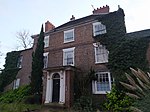Holgate Windmill
1770 establishments in EnglandGrade II listed buildings in YorkGrade II listed windmillsGrinding mills in the United KingdomMill museums in England ... and 6 more
Museums in YorkTower mills in the United KingdomUse British English from August 2015WindmillsWindmills completed in 1770Windmills in North Yorkshire

Holgate Windmill is a tower mill at Holgate in York, North Yorkshire, England which has been restored to working order.
Excerpt from the Wikipedia article Holgate Windmill (License: CC BY-SA 3.0, Authors, Images).Holgate Windmill
Windmill Rise, York Holgate
Geographical coordinates (GPS) Address Website External links Nearby Places Show on map
Geographical coordinates (GPS)
| Latitude | Longitude |
|---|---|
| N 53.9561 ° | E -1.1113 ° |
Address
Holgate Windmill
Windmill Rise 42
YO26 4TX York, Holgate
England, United Kingdom
Open on Google Maps










